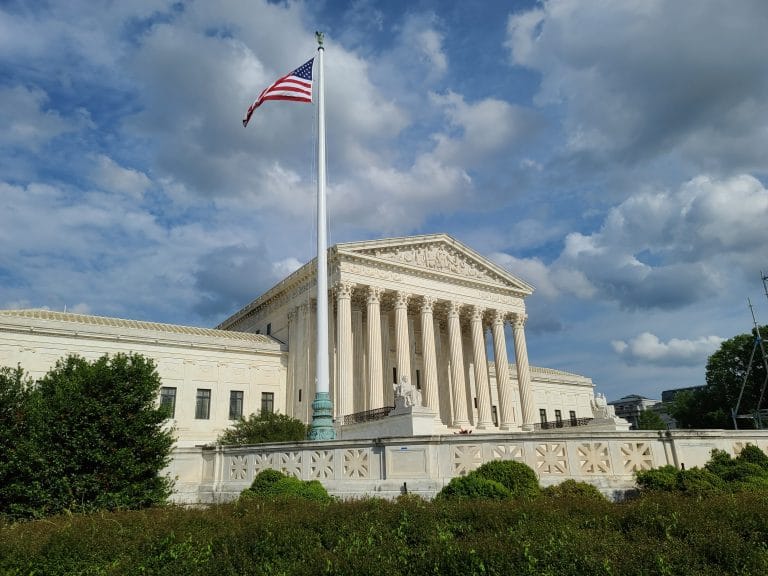In addition to deciding whether the Second Amendment protects the right to carry a gun in public, the Supreme Court may be poised to change the way future courts review gun cases altogether.
The Supreme Court heard oral arguments for the case NYSRPA v. Bruen on Wednesday. Among the flurry of questions probing the scope of the right to carry firearms in public, questions surrounding the standard of review for this case and future gun cases kept surfacing.
“Some of your amici have asked us to provide further guidance to lower courts in cases beyond your own,” Justice Neil Gorsuch said. “They’ve pointed out that some lower courts have refused to apply the history test, for example, and said they will not extend Heller outside the home until this Court does. Other courts have applied intermediate scrutiny and variations of that. Some have suggested that strict scrutiny would be appropriate to treat this right comparably to other rights under our modern tiers of scrutiny.”
The question asked by Justice Gorsuch, one of several that he and other justices asked about appropriate standards of review, highlights the potential for the Court to establish a text, history, and tradition (THT) standard for deciding whether this and other future gun restrictions are constitutional. Such a standard, if officially established, could make it much harder for future gun restrictions to pass constitutional muster.
Paul Clement, who represented the petitioners in the case, argued in favor of the standard.
“I think we would start with the idea that text, history, and tradition is an appropriate way to deal with this right,” Clement said in his response to Justice Gorsuch. “That’s what the Court said in Heller.”
When the Court decided Heller, the landmark 2008 decision that upheld an individual right to own a handgun for self-defense, it relied on a detailed analysis of the Second Amendment’s text combined with a review of historical gun statutes to reach its decision. The Court did not, however, establish text, history, and tradition as a binding standard for lower courts to follow in future Second Amendment cases. As a result, the lower courts have been split over using various traditional balancing tests–such as intermediate scrutiny where a law only has to be substantially related to achieving a legitimate government interest like reducing crime–or applying THT to decide such cases.
Clement argued that the Court could solve that problem by setting the standard of review in this case. He said doing so would correct “some of the mistakes in the lower court to say that text, history, and tradition is the test, not part of the test but the test.” He said it should apply to cases dealing with guns “both inside and outside the home.”
He suggested the Court adopt strict scrutiny, where a law must serve a compelling government interest and be narrowly tailored, as an alternative to THT if it prefers a balancing test because that level of review is “consistent with a fundamental constitutional right.”
Justice Brett Kavanaugh was sympathetic to the argument but expressed skepticism over using traditional balancing tests, including the more strenuous strict scrutiny, in deciding Second Amendment cases.
“And last question, following up on Justice Gorsuch’s question, is he points out some courts have used intermediate scrutiny or strict scrutiny,” Kavanaugh said. “You know, those are balancing tests… But it’ll be no surprise to you I have a concern that would just be a balancing test that would make it a policy judgment, basically, for the courts.”
Further evidence of a growing consensus over the use of the THT standard came from those arguing in favor of New York’s restrictive carry law.
Brian Fletcher, acting Solicitor General arguing on behalf of the United States, also expressed support for a THT test when asked a similar line of questioning from Justice Gorsuch.
“I think our view is that courts ought to follow what we understand to be the lesson from Heller,” he said, “which is that you start with text, history, and tradition. And when those sources provide you an answer one way or the other, either that the law is valid or that it’s invalid, you end there and that’s the end of the inquiry.”
Fletcher said the federal government agreed with Justice Kavanaugh’s approach and argued New York’s restrictive concealed carry law is consistent with the historical record. However, he said its view differed on what to do when the historical record does not provide clear guidance on how to handle a particular gun law. He said the Court should fall back to intermediate scrutiny in those situations.
“At that point, our suggestion is that the way to be faithful to history and tradition is to look to the broader method that you find in that history and tradition,” Fletcher said. “And the method that we find in a half dozen or so cases from the mid-1800s that we cite is to ask whether the law is a reasonable regulation. And as we explained in our brief, we think that the modern judicial method that is most faithful to that approach is a form of intermediate scrutiny.”
A decision in the case is expected by June of 2022.






